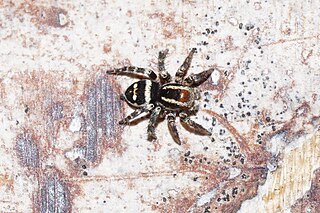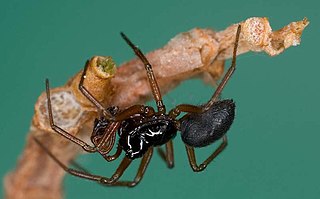
Agelenopsis, commonly known as the American grass spiders, is a genus of funnel weavers first described by C.G. Giebel in 1869. They weave sheet webs that have a funnel shelter on one edge. The web is not sticky, but these spiders make up for that shortcoming by running very rapidly. The larger specimens can grow to about 19 mm in body length. They may be recognized by the arrangement of their eight eyes into three rows. The top row has two eyes, the middle row has four eyes, and the bottom row has two eyes. They have two prominent hind spinnerets, somewhat indistinct bands on their legs, and two dark bands running down either side of the cephalothorax.

Cosmophasis is a genus of spiders in the family Salticidae. They are predominantly Southeast Asian, while some species occur in Africa and Australia. Although most species more or less mimic ants, there are also colorful species that follow a different strategy.

The anatomy of spiders includes many characteristics shared with other arachnids. These characteristics include bodies divided into two tagmata, eight jointed legs, no wings or antennae, the presence of chelicerae and pedipalps, simple eyes, and an exoskeleton, which is periodically shed.

Cosmophasis umbratica is a species of jumping spider found in South and Southeast Asia. These spiders are known for their brilliant, shiny ultraviolet light. They are members of the family Salticidae and the genus Cosmophasis. They are commonly spotted on green vegetation. C. umbratica shows extreme dimorphism when viewed under UV light: males reflect UV on all body parts that are displayed during intraspecific interaction, while females and juveniles do not reflect UV at all. It seems that C. umbratica uses this in sexual signaling. A similar phenomenon is found in some butterflies. For example, several species of Colias and Gonepteryx, both of the family Pieridae, also display sexual signaling.

Titanoeca quadriguttata is a species of spider in the family Titanoecidae. It is widespread in Europe, though absent from Great Britain, and is found in Austria, Belgium, Bulgaria, Corsica, Croatia, Czech Republic, France, Germany, Greece, Hungary, Italy, Liechtenstein, Moldova, Russia, Slovakia, Spain, Switzerland, the Netherlands, Ukraine.

Spiders are air-breathing arthropods that have eight legs, chelicerae with fangs generally able to inject venom, and spinnerets that extrude silk. They are the largest order of arachnids and rank seventh in total species diversity among all orders of organisms. Spiders are found worldwide on every continent except for Antarctica, and have become established in nearly every land habitat. As of August 2022, 50,356 spider species in 132 families have been recorded by taxonomists. However, there has been debate among scientists about how families should be classified, with over 20 different classifications proposed since 1900.

Cyrtophora parangexanthematica is a species of tent spider found in the Philippines. Its scientific name comes from its close resemblance to double-tailed tent spiders. It was described from a single female specimen collected in 1995.
Augacephalus is a genus of harpacterine theraphosid spiders. It has three species, all of which are found in Africa.

Heliophanus cupreus, the copper sun jumper, is a species of jumping spider belonging to the family Salticidae.

Stenaelurillus hirsutus is a species of jumping spider in the genus Stenaelurillus that lives in Central Africa, Congo, Ghana, Kenya, Senegal, Tanzania, and Uganda. It was first described in 1927 by Robert de Lessert. The spider is small, with a cephalothorax that ranges in length between 2.3 and 2.7 mm in length and an abdomen between 2.4 to 2.5 millimetres long. The male is distinguished by its black and white striped pattern on the anterior of the carapace and a mane of light-coloured hairs around the eye field that are reminiscent of a Mohawk hairstyle. The female's epigyne has a deep narrow pocket and bean-shaped copulatory openings. The clypeus has a distinctive pattern of three vertical white stripes on its otherwise black exterior.

Stenaelurillus latibulbis is a species of jumping spider in the genus Stenaelurillus that lives in Democratic Republic of the Congo and Zambia. It was first described in 2014 by Wanda Wesołowska. The spider is medium-sized, with a dark brown cephalothorax between 2.6 and 3.0 mm in length and a black abdomen between {1.9 and 3.4 mm long. The male carapace has patches of white hairs, while the female is marked by two white stripes that stretch from the front to back. The female abdomen has a triangular-shaped white marking. It is distinguished from other members of the genus by the male's short, wide palpal bulb and the female's small epigyne.

Stenaelurillus specularis is a species of jumping spider in the genus Stenaelurillus that the endemic to Malawi. It was first described in 2014 by Wanda Wesołowska. The spider is small, with a brown cephalothorax between 2.1 and 2.8 mm in length and a black abdomen between {2.6 and 3.2 mm long. The carapace has two white streaks and the female abdomen has a triangular-shaped white marking. It is distinguished from other members of the genus by the male's shiny black area on the abdomen, after which the species is named. and the female's short, wide epigyne that has two large oval copulatory openings.

Stenaelurillus iubatus is a species of jumping spider in the genus Stenaelurillus that in endemic to Nigeria. It was first described in 2011 by Wanda Wesołowska and Anthony Russell-Smith. The spider is medium-sized, with a brown carapace between 2.7 and 2.95 mm in length and abdomen between 2.3 and 3.25 mm in length. The male has two stripes of white scales on the carapace and the female has a a heart-shaped white spot on the abdomen. The spider has a distinctive mane-like long hairs on its black eye field, which is recalled in the species name that is derived from the Latin for mane. It can be distinguished from other species in the genus by the ribbon-shaped embolus on the male and highly sclerotized epigyne with its narrow pocket and widely separated copulatory openings on the female.

Phintella caledoniensis is a species of jumping spider in the genus Phintella that lives in New Caledonia. First described in 2009 by Barbara Patoleta, it was named after the island where it was found. The spider is small and has a brown cephalothorax with patches, the female being generally darker, and a grey or grey-brown abdomen. The female has distinctive bean-shaped spermatheca and the male a long and thin embolus.

Erigone atra is a species of dwarf spider or money spider, in the family Linyphiidae. It is commonly found in North America, Europe, parts of Russia, Central Asia, China, Mongolia, Korea, and Japan. This spider is one of the most common Erigone spiders. E. atra is an important spider for agriculture, as it preys on pests such as aphids which are commonly found on crops. E. atra spiders are aeronautical spiders, as they travel via ballooning. This technique, sometimes referred to as kiting, allows E. atra spiders to traverse large distances and find new habitats when environmental or human stresses create unfit living environments. E. atra is difficult to differentiate from other congeneric species because of their similar sizes and coloring.

Plexippus petersi is a species of jumping spider native to Asia and has been introduced to Africa and Pacific islands. The male is between 6 and 10 mm in length, and the female is around 10 millimetres (0.39 in). This spider is commonly known as the tropical flycatcher or small zebra jumper.
Exechocentrus lancearius is a species of spider in the orb-weaver spider family Araneidae, found only in Madagascar. It was initially described from a partial specimen of an adult female. The first description of a complete specimen and its prey-catching behaviour was published in 2012. E. lancearius is a bolas spider. Rather than using a web, adult females catch their prey by using a line with one or two sticky drops which they swing.

Carrhotus viduus is a species of spider in the family Salticidae. It is found in South and Southeast Asia. It is the type species of the genus Carrhotus.

Cosmophasis lami, also known as the Lami Beach northern jumping spider or tangerine garden jumper, is a species of jumping spider in the genus Cosmophasis, probably native to South East Asia and some pacific islands, and possibly introduced to Japan and Okinawa Islands by humans. It was first described by Berry, Beatty & Prószynski in 1997 and has one synonym, Cosmophasis squamata (Saaristo,2002) Both the female and the male have been described.

Cosmophasis gemmans is a species of jumping spider in the family Salticidae. Only the male has been described. The type specimen is deposited at the Museo Civico di Storia Naturale di Genova.
















